Making a Mark on History
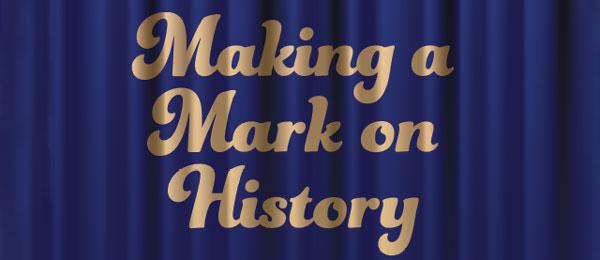
Making a Mark on History
Current and former AMA members among recipients of distinguished honor
By | [email protected]
Photos by the author and as noted
Burt Rutan, Paul MacCready, Neil Armstrong, and Frank Borman are some of the most well-known names in the model, full-scale aviation, and spaceflight worlds. In addition to sharing a passion for things that fly, they are among an elite list—a list that only the best of the best are on. They are merely a handful of the recipients of the distinguished Robert J. Collier Trophy.
"This is like the Oscars for best aircraft design in the US aerospace industry," stated AMA member Matt Keennon of AeroVironment, Inc., a company for which he works. AeroVironment was recognized as one of the 2021 recipients of the Collier Trophy for the Mars Ingenuity project. The winners of the trophy were honored at an award dinner in 2022. Matt helped design Ingenuity while working for the company. The 2021 trophy was officially awarded to NASA’s Jet Propulsion Laboratory (JPL) Ingenuity Mars Helicopter team.
The trophy is given "for the greatest achievement in aeronautics or astronautics in America, with respect to improving the performance, efficiency, and safety of air or space vehicles, the value of which has been thoroughly demonstrated by actual use during the preceding year," according to the National Aeronautic Association (NAA) website. The Collier Trophy Committee is a panel of judges overseen by the NAA that reviews the trophy nominees each year.

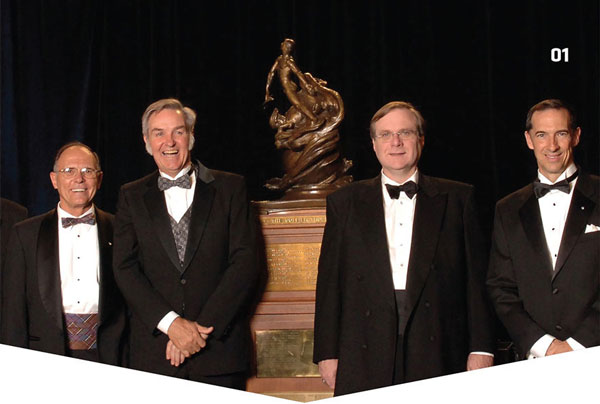
AMA member Burt Rutan stands left of the 2004 Collier Trophy, which he and others received for SpaceShipOne. Photo provided by Burt Rutan.
 DISCOVER MORE CONTENT!
DISCOVER MORE CONTENT!
More pictures are available in AMA’s Flickr gallery at https://flic.kr/s/aHBqjAH11n.
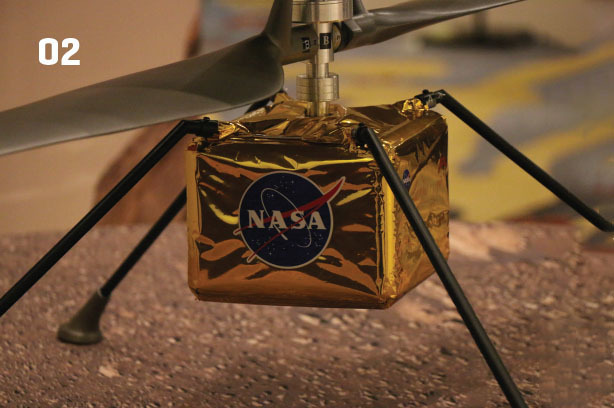 A close-up photo of a version of the Mars Ingenuity Helicopter at the June 2022 Collier Trophy Dinner.
A close-up photo of a version of the Mars Ingenuity Helicopter at the June 2022 Collier Trophy Dinner.
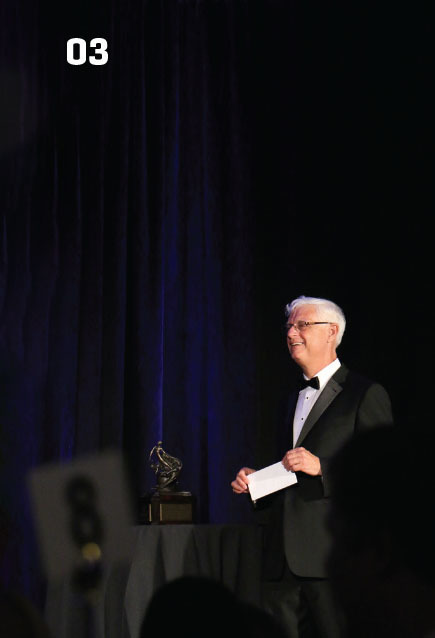
Greg Principato smiles while presenting at the 2021 Robert J. Collier Trophy Dinner. He is standing next to a small copy of the trophy
During the 2021 Collier Trophy dinner, held June 9, 2022, at the Marriott Marquis in Washington, D.C., Greg Principato, then-president of NAA, stated, "At the end of the selection process, one of the judges said, ‘If you can’t get a trophy for flying a helicopter on Mars, what the heck can you do to get one?’"
Mars Ingenuity made its historic first flight on April 3, 2021. Years before the RC helicopter flew in 1/3 of the amount of gravity that there is on Earth, Burt broke records with his Voyager aircraft. He was selected for the 1986 Collier Trophy for the Rutan Model Voyager aircraft, which made the first nonstop, non-refueled flight around the world. Also listed as recipients of the award that year are Jeana Yeager, Dick Rutan, and the Voyager Aircraft team of volunteers.
"[It] felt great, of course," Burt stated about receiving the Collier Trophy in 1987. The honor has been bestowed since 1911 and is typically awarded annually. The 7-foot trophy is kept at the Smithsonian National Air and Space Museum in Washington, D.C. The award weighs 525 pounds and is named after Robert J. Collier, the publisher of Collier’s Weekly magazine. He was also an air sports pioneer and the president of the Aero Club of America.
A year after Burt was honored, fellow AMA member Susan Weisenbach Johnson, the NASA Lewis Research Center, and the NASA/Industry Advanced Turboprop team received the Collier Trophy for the development of advanced turboprop-propulsion concepts. The design was for single rotation, gearless counterrotation, and geared counterrotation inducted-fan systems. Although not named on the trophy, Susan was part of the team that received the award.
"It was a great honor for the program to be selected," Susan stated. "The previous award recipients are iconic in aviation milestones. I was a member of the program management team, as well as having several contracts with the military."
Susan did not attend the award ceremony, but she stated that the NASA center director, Dr. John Klineberg, accepted the award on behalf of the NASA team. The ceremony took place in Washington, D.C., in 1988.
In all, Burt attended two Collier Trophy dinners. He again received the Collier Trophy in 2005 for SpaceShipOne, the first privately financed, built, and flown spacecraft. Other recipients for this 2004 award included Paul Allen, Doug Shane, Mike Melvill, and Brian Binnie. Before retiring, Burt was the owner of Scaled Composites.
"My whole career I have tried to do the ‘impossible,’ even though it was thought to be out of reach," Burt said about his career.
When asked why he felt that the Mars Ingenuity project was deserving of the Collier Trophy, Burt, an AMA Life Member, answered, "Because it is a unique accomplishment. It’s like developing a drone capable of flying at 100,000 feet altitude in Earth’s atmosphere. That is how thin Mars’ atmosphere is on its surface."
When Matt and his team learned in April 2022 that their project was selected for the Collier Trophy, he couldn’t help but think of his mentor, Paul, who was selected for the 1979 Collier Trophy for designing and constructing the Gossamer Albatross. The aircraft made the first man-powered flight across the English Channel. Pilot Bryan Allen was also named on the award.
"Both Ingenuity and the Albatross aircraft attacked challenges in similar technical approaches, and both used the same fundamental rotor blade design," Matt commented. "There is a strong feeling of pride with the connection of the two programs.
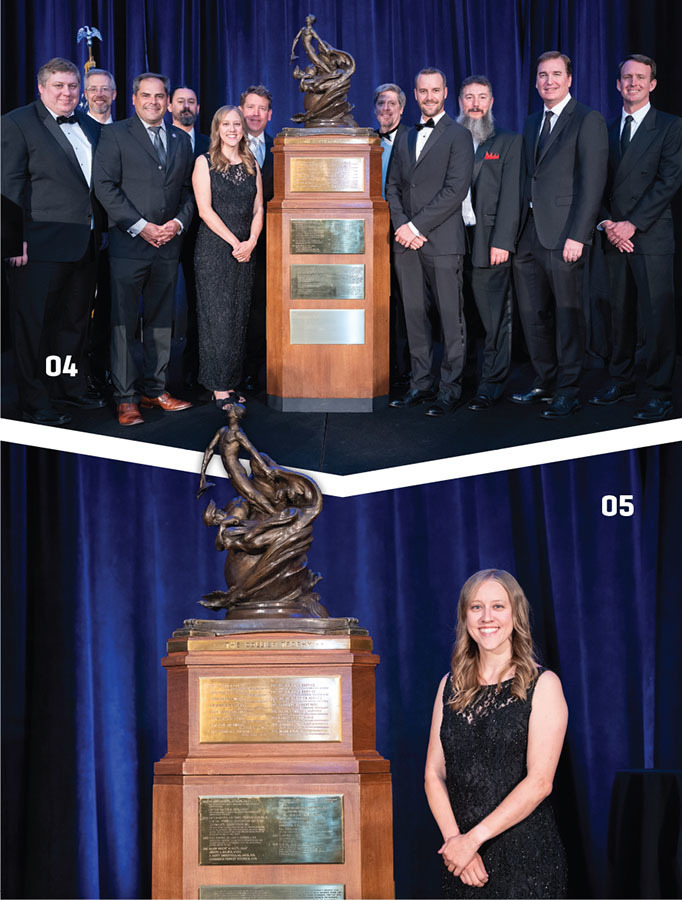
04. The AeroVironment, Inc. team poses next to the Collier Trophy following the award ceremony. Photo by Daniel Stanley. 05. Sara Langberg and the Collier Trophy. Stanley photo.
"With Ingenuity at a mere 3 pounds, it must be the lightest Collier Award-winning aircraft by far, which is really cool," Matt said.
Paul passed away on August 28, 2007, roughly six years before AeroVironment took on the Mars Ingenuity project. When asked what Paul might have thought about Matt, his coworkers, and others receiving the honor, Matt stated, "He would have been really happy. He would have said, ‘Well, it’s obvious,’ that the project deserved the award. He had a dry sense of humor."
As a modeler, Paul had numerous achievements. These included winning the U.S. National Soaring Championships multiple times, developing high-altitude wave soaring in the US, being the first American modeler to become an international RC sailplane champion, and inventing the MacCready speed ring for gliders. He founded AeroVironment, Inc. in 1971. Matt was hired by AeroVironment in 1995.
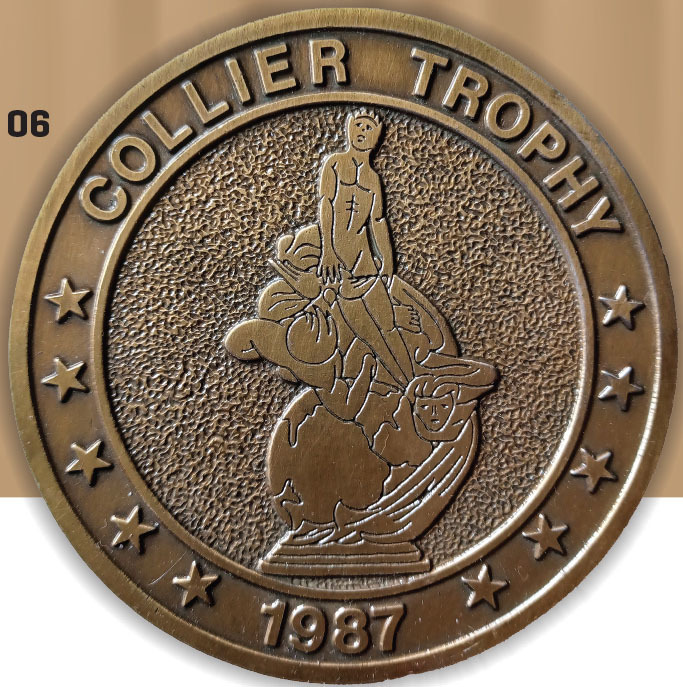
A 1987 Collier Trophy medallion owned by Susan Johnson.
"I am really pleased about sharing company with Paul and the Albatross team. That means the most to me because as a boy, I really idolized Paul, and had the good fortune to know him and work at his company, which I still do today," Matt concluded.
Another Collier Trophy recipient who has since passed away is astronaut Neil Armstrong. Neil, a former AMA member, and his fellow Apollo 11 astronauts, Buzz Aldrin and Michael Collins, received the 1969 Collier Trophy for their historic spaceflight that resulted in Neil and Buzz walking on the moon on July 20, 1969. Neil passed away August 25, 2012.
An additional astronaut and former AMA member, Frank Borman, and his Apollo 8 crewmates, James "Jim" Lovell Jr. and William Anders, received the 1968 Collier Trophy for successfully completing the first manned lunar orbit. Frank, now age 94, did not return requests to comment for this article. He was an AMA member until 2013.
Now-retired NASA employee Susan has been an AMA member since 1959. She worked at NASA Glenn (previously Lewis) Research Center in Cleveland, Ohio, for 46-1/2 years. "I was a research engineer (AST Aerospace Engineer) working on leading-edge propulsion technologies for general aviation engines and subsonic turbine engines. Later, I was an engineer project manager, leading propulsion research work for subsonic and supersonic aircraft, hypersonic vehicles, and electric propulsion helicopters," she stated.
In the 1970s, the initial propeller concepts for the advanced turboprop systems for which Susan and her team would later receive the Collier Trophy were generated. "Advanced propeller designs involving thin, highly swept and twisted blades emerged from cooperative research at NASA Lewis and Hamilton Standard. The feasibility of achieving major improvements in aerodynamic efficiency with these unique propellers operating at high subsonic speeds (Mach 0.8) was subsequently demonstrated in wind tunnel tests," Susan explained.
"The NASA/Industry Advanced Turboprop Team has produced a major achievement in aeronautics through the conception, development, and flight verification of advanced turboprop propulsion technology applicable to several new aircraft propulsion systems," Susan continued.
"This technology base provides for future commercial development of single-rotation and counterrotation turboprop propulsion systems that offer dramatic reductions in fuel usage and operating costs. They are expected to engender a new generation of subsonic transport aircraft for both civil and military uses."
Susan’s aptitude in math and science partly led to her career at NASA.
Math and science also played large roles in the Mars Ingenuity project. "I worked on a lot of the subsystems for the helicopter, testing components, flushplate and linkage geometry, [and] geometry for how the landing gear legs fold," stated Sara Langberg, an aeromechanical engineer at AeroVironment.
Sara explained more about her work on Ingenuity. "I [learned that] everything on Ingenuity had to be extremely purpose-built and highly optimized. We had to be really creative with our designs. [They were] unconventional." The aircraft has a nonlinear (offset) swashplate and was crafted with lightweight parts. "Also, the spring and damper system on the landing gear had no foil, [and had] restriction dampers and [materials that are not] traditionally used," she continued. "We used really soft aluminum instead. No part was designed without the rest of the helicopter in mind."
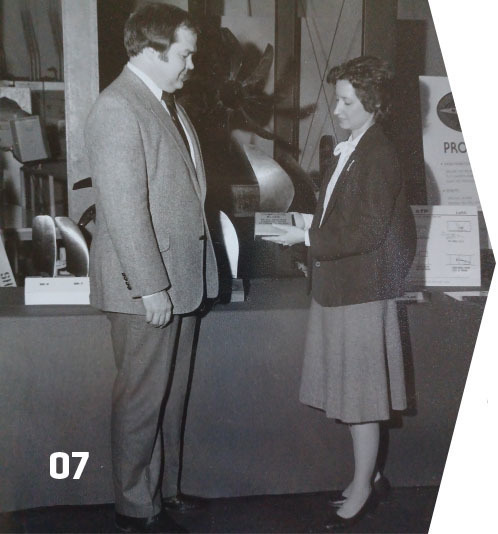
Susan and Dr. Larry Bober look at a composite propfan.
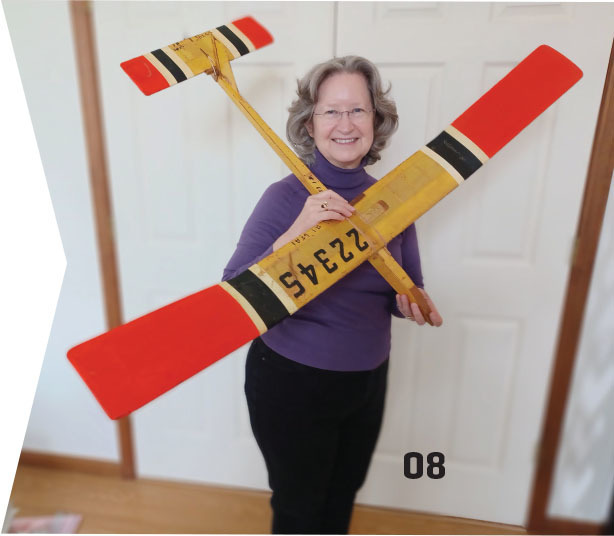
In this photo taken in March 2023, Susan holds her favorite A1 Towline glider that won the 1966 Nats. Photo provided by Susan Johnson.
Sara also did much work on the RC helicopter’s main structure and other assembly components. Although she didn’t get to test-fly the heli, she saw others fly it in a special chamber at JPL.
At the 2022 Collier Trophy Award dinner, Sara, Matt, and their coworkers, Ben Pipenberg (a former AMA member), Jason Firanski, Karl Klingebiel, Laurant Heughebaert, Joey Beckman, Steven Chambers, Jon Ross, Chris Bang (who is no longer employed by AeroVironment but was the program manager for the company throughout most of the Mars Helicopter project) took turns posing with a small replica of the trophy in the lobby area of the hotel.
Sara described her experience of attending the award ceremony. It was "very, very cool and a little bit surreal. I had a moment, kind of, before the award ceremony [when they were] showing helicopter pictures and past Collier pictures with the trophy, and I looked over and there was the trophy. It was a very humbling experience. I’m absolutely honored to have been a part of all of it."
Although Sara, Matt, and the rest of the team weren’t among those called to the stage to receive the honor, the efforts that they put forth were not unnoticed. "AeroVironment has been an integral part of this project almost from the beginning," Dr. Havard Grip of JPL said during the award dinner. "We really had the A team on this, and we couldn’t have done it without them." Matt and his coworkers were then asked to stand to be recognized. The room erupted in applause for the AeroVironment team and others who helped with the project.
Matt had this to say about the Mars Ingenuity project winning the trophy, after traveling home to California from the award ceremony: "I believe it shows a shift in the perception of the importance of small-sized UAVs, that in the past were judged as mere ‘model airplanes’ but now are judged more fairly on their merits by the public and industry."
SOURCES:
Paul MacCready
AMA History Project Biography
www.modelaircraft.org/sites/default/files/MacCreadyDrPaul.pdf
Burt Rutan
AMA History Project Biography
www.modelaircraft.org/sites/default/files/RutanElbertBurt.pdf
"Destination Mars"
AeroVironment, Inc.
"One Small Step With Model Aviation"
NAA/Collier Trophy







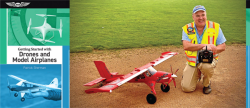
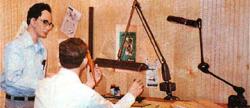

Add new comment